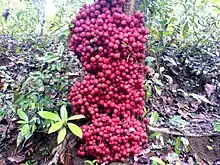Baccaurea courtallensis
Baccaurea courtallensis is a species of flowering plant belonging to the family Phyllanthaceae.[1][2] It is endemic to the Western Ghats mountains in India. It is a medium size evergreen understory tree frequent in tropical wet evergreen forests of the low and mid-elevations (40-1000m). It is a Near Threatened species according to the IUCN Red List of Threatened Species[3].
| Baccaurea courtallensis | |
|---|---|
 | |
| Scientific classification | |
| Kingdom: | Plantae |
| Clade: | Tracheophytes |
| Clade: | Angiosperms |
| Clade: | Eudicots |
| Clade: | Rosids |
| Order: | Malpighiales |
| Family: | Phyllanthaceae |
| Genus: | Baccaurea |
| Species: | B. courtallensis |
| Binomial name | |
| Baccaurea courtallensis (Wight) Müll.Arg. | |
| Synonyms | |
| |
Description
It is a medium size tree up to 10-18m tall and girth up to 1.3 m.[1][3][4] Bark is grey and generally smooth or scaly. The leaves are simple, alternate and clustered at twig end. The leaf petiole is 1.2 to 3.8 cm long and swollen at both ends.
The flowers are scarlet in colour and dioecious. Inflorescence are in long stalks arranged in clusters growing on the trunk of the tree i.e. cauliflorous.[5] Male inflorescence is clustered all over the trunk. Female inflorescence is clustered mostly at the base of the trunk.[3] The fruit are globose, crimson coloured and ribbed.[6]
Common names
Malayalam: Mootilpazham, Mootilthoori, Mootippuli, Mootikaya[7][8]
Kannada: Kolikukke, Kodikukke, Kolakukki[7][8]
Tamil: Kuran Pazam[9]
Distribution and habitat
This tree is endemic to the Western Ghats.[3]
Ecology
Flowering: Aug, Nov, Dec.[1][3] Leaf buds and fruits are eaten by Nilgiri Langurs,[10] Elephants and Lion-tailed Macaques were also known to feed on the ripe fruits.[11]
Gallery
 Baccaurea courtallensis flowers
Baccaurea courtallensis flowers Baccaurea courtallensis flowers
Baccaurea courtallensis flowers Baccaurea courtallensis fruits
Baccaurea courtallensis fruits Baccaurea courtallensis fruits
Baccaurea courtallensis fruits.jpg.webp) Baccaurea courtallensis fruits
Baccaurea courtallensis fruits.jpg.webp) Baccaurea courtallensis fruits
Baccaurea courtallensis fruits
References
- "Baccaurea courtalensis - EUPHORBIACEAE". www.biotik.org. Retrieved 2022-07-13.
- Peter, K. V. (2 June 2008). Underutilized and Underexploited Horticultural Crops: Vol.03. ISBN 9788189422851.
- Page, N (2017). A Photographic Guide-Endemic Woody Plants of the Western Ghats. Pp.iii+201. Trial Blazer Printers and Publishers. Bangalore.
- Brandis, Dietrich (1906). Indian trees : an account of trees, shrubs, woody climbers, bamboos, and palms indigenous or commonly cultivated in the British Indian empire. London: A. Constable.
- Hooker, Joseph Dalton (1890). The flora of British India. Vol. 5. London: L. Reeve.
- Cooke, Theodore.; Cooke, Theodore (1903). The flora of the presidency of Bombay. Vol. 2. London: Taylor and Francis.
- "Baccaurea courtallensis - Mootapalam". www.flowersofindia.net. Retrieved 2022-07-13.
- Gamble, J. S. A manual of Indian timbers; an account of the growth, distribution, and uses of the trees and shrubs of India and Ceylon with descriptions of their wood-structure (New and revised ed.). London: S. Low, Marston & co. ltd.
- Mathpati, Mahesh and Vaishnavi C (2013). Useful plants that are increasingly rare, as perceived by the Adivasi Community in the Gudalur Region". Action for Community Organisation, Rehabilitation and Development, Gudalur
- Ramachandran, K. K. (1995). Status survey of primates in Shendurney Wildlife Sanctuary and adjacent areas. KFRI Research Report 106. December 1995. Kerala Forest Research Institute, Peechi, Thrissur. Pp. 34
- "Baccaurea courtallensis – Karthik's Journal". Retrieved 2022-07-13.